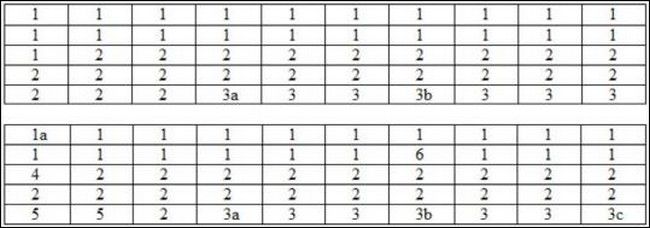
Le timbre suivant de la Chine allemande (Tsingtau) peut être considéré comme le premier timbre provisoire allemand.
Die folgende Briefmarke von Deutsch-China (Tsingtau) kann als erste deutsche Provisoriumsmarke betrachtet werden.
The following stamp of German China (Tsingtau) can be considered as the first German provisional stamp.
Le timbre est bien sûr dentelé!
Il y eut trois différentes impressions et une multitude de types différents.
Vers le 9 mai 1900 la direction de la poste de Tsingtau à Kiautschou laisse surcharger les timbres de 10 Pfennig rouge par 5 Pfennig par pénurie de timbres à 5 Pfennig.
C'est le manque de lettres et chiffres dans l'imprimerie qui a conduit aux différents types.
Voici les différents types (images du journal Senf).
Die Marke ist natürlich gezähnt!
Es gab drei verschiedene Drucke und eine Vielzahl unterschiedlicher Typen.
Um den 9. Mai 1900 liess die Postdirektion von Tsingtau in Kiautschou die Briefmarken der roten 10 Pfennig wegen Mangels an 5 Pfennig-Briefmarken mit 5 Pfennig überdrucken.
Es war der Mangel an Buchstaben und Zahlen in der Druckerei, der zu den verschiedenen Typen führte.
Hier sind die verschiedenen Typen (Bilder aus der Zeitung Senf).
The stamp is of course perforated!
There were three different impressions and a multitude of different types.
Around May 9th, 1900, the post office management of Tsingtau in Kiautschou let the stamps of 10 red Pfennigs be overprint by 5 Pfennig due to a shortage of 5 Pfennig stamps.
It was the lack of letters and numbers in the printing house that led to the different types.
Here are the different types (pictures from the Senf newspaper).
La première impression se fit sur deux demi-feuilles de 50 timbres.
Le planchage est le suivant (chaque chiffre dans les cases correspond au type):
Der erste Eindruck wurde auf zwei Halbbögen mit 50 Briefmarken gemacht.
Die Plattierung ist wie folgt (jede Zahl in den Feldern entspricht dem Typ):
The first impression was made on two half-sheets of 50 stamps.
The positioning is as follows (each number in the cases corresponds to the type):

La deuxième impression se fit en une feuille de 100 timbres avec 10 types.
Der zweite Druck wurde in einem Bogen von 100 Briefmarken mit 10 Typen durchgeführt.
The second printing was done in a sheet of 100 stamps with 10 types.

Les types 1 et 2 sont identiques avec la première impression.
Pour le type 3, le 5 Pfg est plus petit.
Type 4 équivaut au type 2, mais un grand 5 recouvre le chiffre 10.
Type 5 a un grand chiffre 5 qui recouvre le petit 5 du type 3.
Type 6 correspond au type 5, mais a en plus un grand chiffre 5 qui recouvre l'ancienne valeur 10.
Type 7 montre un petit 5 de type 3, ainsi qu'un Pf. de type 1.
Type 8 comme type 7, mais point derrière Pf en élévation.
Type 9 nous montre fP au-lieu de Pf.
Il existe un type 10, mais je n'ai aucune indication.
Pour la troisième impression ordonnée par la poste de Futschau en août 1900 on trouve la surcharge 5 pf en petites lettres sans point derrière pf.
La longeur de cette surcharge est de 8 ½ mm.
Die Typen 1 und 2 sind identisch mit dem ersten Ausdruck.
Bei Typ 3 ist die 5 Pfg kleiner.
Typ 4 ist derselbe wie Typ 2, aber eine große 5 deckt die Zahl 10 ab.
Typ 5 hat eine große 5, die die kleine 5 von Typ 3 überlappt.
Typ 6 entspricht dem Typ 5, hat aber auch eine große 5, die die alte 10 überlappt.
Typ 7 zeigt eine kleine 5 vom Typ 3, sowie einen Pf. vom Typ 1.
Typ 8 wie Typ 7, aber Punkt hinter Pf in der Höhe.
Typ 9 zeigt uns fP anstelle von Pf.
Es gibt einen Typ 10, aber ich habe keinen Hinweis.
Für den dritten Druck, der im August 1900 von der Post Futschau bestellt wurde, finden wir den Zuschlag 5 pf in Kleinbuchstaben ohne Punkt hinter pf.
Die Länge dieses Zuschlags beträgt 8 ½ mm.
Types 1 and 2 are identical with the first printout.
For type 3, the 5 Pfg is smaller.
Type 4 is the same as type 2, but a large 5 covers the number 10.
Type 5 has a large 5 that overlaps the small 5 of type 3.
Type 6 is equivalent to type 5, but also has a large 5 that overlaps the old 10.
Type 7 shows a small 5 of type 3, as well as a Pf. of type 1.
Type 8 as type 7, but point behind Pf in elevation.
Type 9 shows us fP instead of Pf.
There is a type 10, but I have no indication.
For the third printing ordered by the Futschau post office in August 1900 we find the surcharge 5 pf in small letters without dot behind pf.
The length of this surcharge is 8 ½ mm.
Document généré en 0.02 seconde